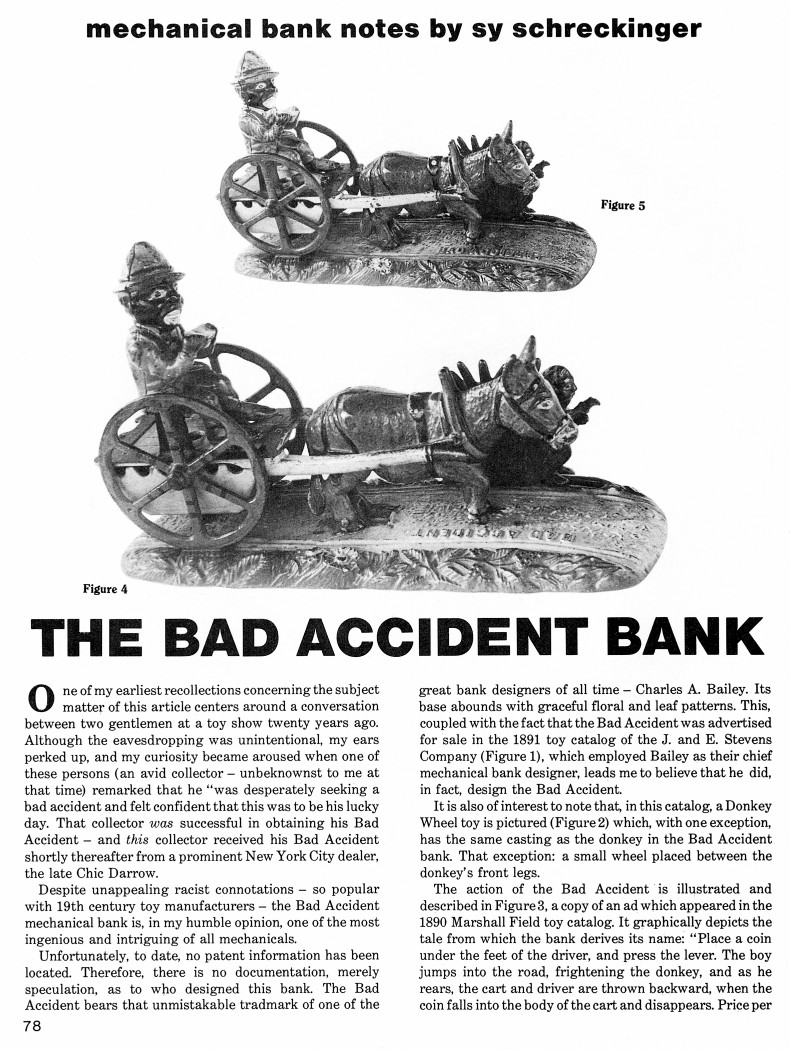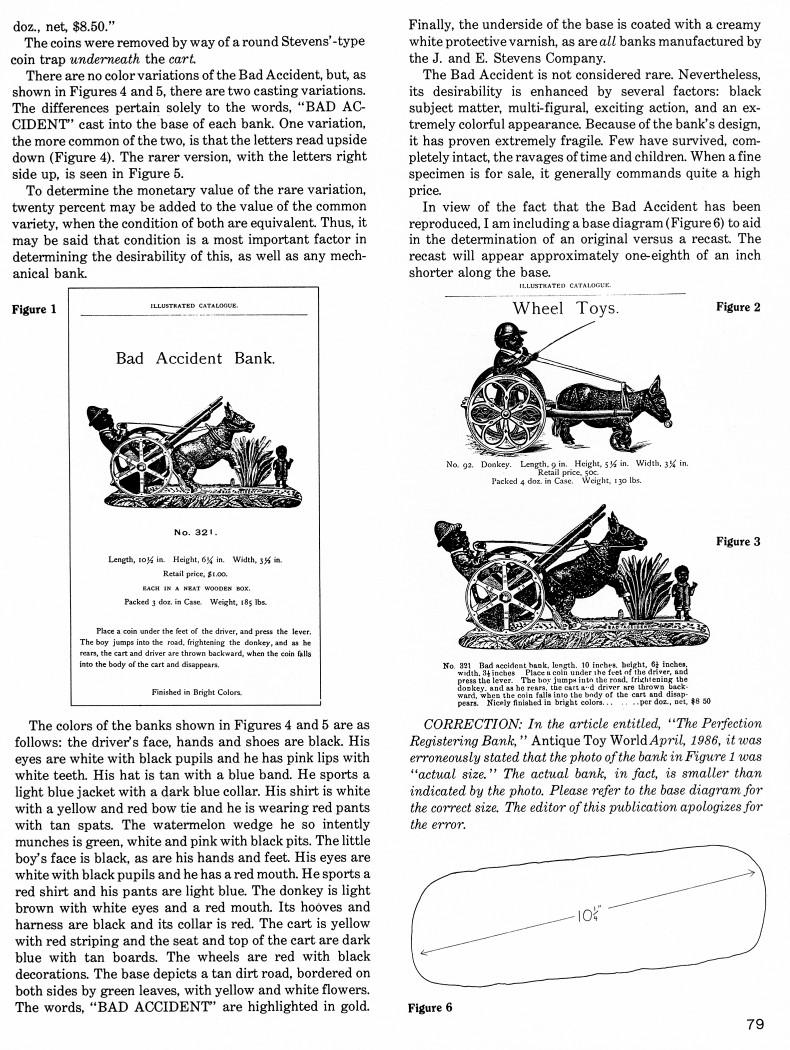|
The Bad Accident Bank
by Sy Schreckinger – ANTIQUE TOY WORLD Magazine – June, 1986
One of my earliest
recollections concerning the subject matter of this article centers around
a conversation between two gentlemen at a toy show twenty years ago.
Although the eavesdropping was unintentional, my ears perked up, and my
curiosity became aroused when one of these persons (an avid collector —
unbeknownst to me at that time) remarked that he "was desperately seeking
a bad accident and felt confident that this was to be his lucky day. That
collector was successful in obtaining his Bad Accident — and this
collector received his Bad Accident shortly thereafter from a prominent
New York City dealer, the late Chic Darrow.
Despite unappealing racist connotations — so popular with 19th
century toy manufacturers — the Bad Accident mechanical bank is, in my
humble opinion, one of the most ingenious and intriguing of all
mechanicals.
Unfortunately, to date, no patent information has been located.
Therefore, there is no documentation, merely speculation, as to who
designed this bank. The Bad Accident bears that unmistakable trademark of
one of the great bank designers of all time — Charles A. Bailey. Its base
abounds with graceful floral and leaf patterns. This, coupled with the
fact that the Bad Accident was advertised for sale in the 1891 toy catalog
of the J. and E. Stevens Company (Figure 1), which employed Bailey as
their chief mechanical bank designer, leads me to believe that he did, in
fact, design the Bad Accident.
It is also of interest to note that, in this catalog, a Donkey Wheel
toy is pictured (Figure 2) which, with one exception, has the same casting
as the donkey in the Bad Accident bank. That exception: a small wheel
placed between the donkey's front legs.
The action of the Bad Accident is illustrated and described in Figure
3, a copy of an ad which appeared in the 1890 Marshall Field toy catalog.
It graphically depicts the tale from which the bank derives its name:
"Place a coin under the feet of the driver, and press the lever. The boy
jumps into the road, frightening the donkey, and as he rears, the cart and
driver are thrown backward, when the coin falls into the body of the cart
and disappears. Price per doz., net, $8.50."
The coins were removed by way of a round Stevens'-type coin trap
underneath the cart.
There are no color variations of the Bad Accident, but, as shown in
Figures 4 and 5, there are two casting variations. The differences pertain
solely to the words, "BAD ACCIDENT" cast into the base of each bank. One
variation, the more common of the two, is that the letters read upside
down (Figure 4). The rarer version, with the letters right side up, is
seen in Figure 5.
To determine the monetary value of the rare variation, twenty percent
may be added to the value of the common variety, when the condition of
both are equivalent. Thus, it may be said that condition is a most
important factor in determining the desirability of this, as well as any
mechanical bank.
The colors of the banks shown in Figures 4 and 5 are as follows: the
driver's face, hands and shoes are black. His eyes are white with black
pupils and he has pink lips with white teeth. His hat is tan with a blue
band. He sports a light blue jacket with a dark blue collar. His shirt is
white with a yellow and red bow tie and he is wearing red pants with tan
spats. The watermelon wedge he so intently munches is green, white and
pink with black pits. The little boy's face is black, as are his hands and
feet. His eyes are white with black pupils and he has a red mouth. He
sports a red shirt and his pants are light blue. The donkey is light brown
with white eyes and a red mouth. Its hooves and harness are black and its
collar is red. The cart is yellow with red striping and the seat and top
of the cart are dark blue with tan boards. The wheels are red with black
decorations. The base depicts a tan dirt road, bordered on both sides by
green leaves, with yellow and white flowers. The words, "BAD ACCIDENT" are
highlighted in gold. Finally, the underside of the base is coated with a
creamy white protective varnish, as are all banks manufactured by the J.
and E. Stevens Company.
The Bad Accident is not considered rare. Nevertheless, its
desirability is enhanced by several factors: black subject matter,
multi-figural, exciting action, and an extremely colorful appearance.
Because of the bank's design, it has proven extremely fragile. Few have
survived, completely intact, the ravages of time and children. When a fine
specimen is for sale, it generally commands quite a high price.
In view of the fact that the Bad Accident has been reproduced, I am
including a base diagram (Figure 6) to aid in the determination of an
original versus a recast. The recast will appear approximately one-eighth
of an inch shorter along the base.
CORRECTION: In the article entitled, "The Perfection
Registering Bank, " Antique Toy World
April, 1986, it was erroneously
stated that the photo of the bank in Figure 1 was "actual size. " The
actual bank, in fact, is smaller than indicated by the photo. Please refer
to the base diagram for the correct size. The editor of this publication
apologizes for the error.
|


